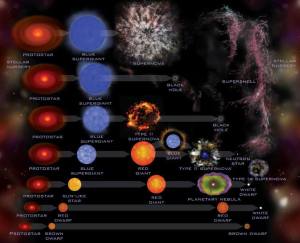Stars go through the same process that we do in the sense that they are born, live, and then die. The difference is that they do it far more dramatically, and take a much longer time doing it. Depending on the mass of the star, the lifetime can range from a few million years to trillions of years!
The birthplace of a star is a huge, cold cloud of gas and dust, nebulae/nebulas. These clouds begin to shrink, a result of their own gravity. As a cloud begins to shrink it gets smaller and the cloud breaks up into clumps. Eventually, these clumps reach high enough temperatures and get so dense that nuclear reactions begin. When the temperature reaches about 10 million degrees Celsius, the clump becomes a new star, a protostar. A protostar is not very stable. In order to live on, the protostar will need to achieve and maintain equilibrium, a balance between gravity pulling atoms towards the center of the protostar and gas pressure pushing heat and light away from the center. When a star can no longer maintain this balance, it dies.
If the critical temperature in the core of a protostar is never reached, it ends up as a brown dwarf, never achieving “star status”. However, if the critical temperature in the core of a protostar is reached then nuclear fusion begins. It is no longer classified as a protostar. It’s defined as a star in the moment that it begins fusing the hydrogen in the core into helium. Simply put, nuclear fusion is a nuclear reaction where two or more atomic nuclei collide at high speeds and form a new type of atomic nucleus, in this case hydrogen forms helium.
At “Star Status,” stars spend the majority of their lives fusing hydrogen. Well, the stars fuse helium into carbon and after a while, into even heavier elements. Maintaining the balance between gravity and gas pressure becomes very hard. The stars eventually start to collapse on themselves. Before the star’s inevitable collapse, nuclear reactions outside of the core cause the dying star to expand outwards and this is what we call the “Red Giant” phase.
How dramatic the death is, depends on the mass of the star. Our Sun is expected to turn into a white dwarf star. If a star has a slightly larger mass than our Sun, it may undergo a supernova explosion and leave behind a neutron star. If even larger, at least three times the mass of the Sun, the star could even implode to form an infinite gravitational warp in space, a black hole!

